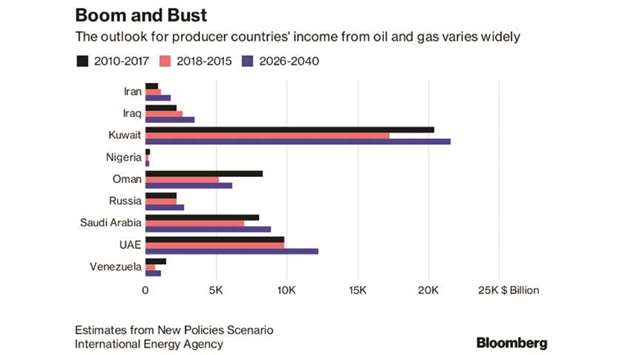Bloomberg/London
Countries heavily reliant on oil and gas for revenue must diversify their economies or face worsening finances, the International Energy Agency warns in a new report.
While revenue for petro-states has always fluctuated in boom-and-bust price cycles, this time is different. Surging US shale production, the expansion of renewables and increases in energy efficiency pose a more fundamental challenge.
“Now, more than at any other point in recent history, fundamental changes to the development model look unavoidable,” IEA executive director Fatih Birol said in an interview. “Countries cannot afford to base their economies on oil and gas revenue only. It’s high time to diversify their economies.”
The most obvious answer to the diversification question, particularly for Middle Eastern producers, is to ramp up solar power capacity, the IEA says.
Around 2mn bpd of oil is used for electricity generation in the Arabian Gulf, according to Birol. “This is very inefficient. It’s like using Chanel perfume to fuel your car,” he said.
Prices will come under pressure over the long term, the IEA says, because of rising US shale oil production, increased energy efficiency and policies to curb climate change and local air pollution.
“A big amount of shale oil is coming onto the market,” Birol said. “We expect between now and 2030 more than 50% of global oil production growth will come from shale oil.”
Since the price crash in 2014, net income from oil and gas has plunged for producer countries. For Iraq the drop was around 40%; for Venezuela it was as much as 70%.
The risk of failing to diversify away from oil and gas is outlined in the IEA’s Low Oil Price Case scenario, where it assumes crude settles in a range between $60 to $70 a barrel.
In the Middle East, this would equate to a $1,500 drop, compared to the IEA’s base case New Policies Scenario, in average annual disposable income per person, the IEA said. In countries with rising, young populations in need of jobs this would be critical.
If crude prices average around $60-70 a barrel between now and 2040, net oil and gas income across the industry will never recover to 2010 to 2015 levels, the IEA said. This would lead to a cumulative $7tn loss in revenue, through to 2040.
“Without far-reaching reforms, this would translate into large current account deficits, downward pressure on currencies and lower government spending,” the report said.
Saudi Arabia’s Vision 2030, a plan to wean its economy off oil, was unveiled in 2016 to much fanfare but concrete reforms have been lacklustre. While the IEA stops short of singling out the world’s largest oil exporter as being especially at risk, it highlights how the kingdom remains “heavily dependent on hydrocarbon revenues today” despite having first expressed a desire to diversify its economy back in 1970.
The IEA says that how these producer countries adapt is crucial, not just for the survival of their own economies but also for global energy security and environmental sustainability. Maintaining investment in low-cost and low- carbon energy resources is vital.
The disadvantages of being heavily dependent on oil and gas revenues are evident in the recent history of the global economy, the IEA said.
“Producer economies have not performed significantly better in economic terms than non-producers in recent years, despite having access to vast revenue streams from oil and gas,” the report said. “More than at any other point in recent history, fundamental changes to the development model in resource-rich countries look unavoidable.”



